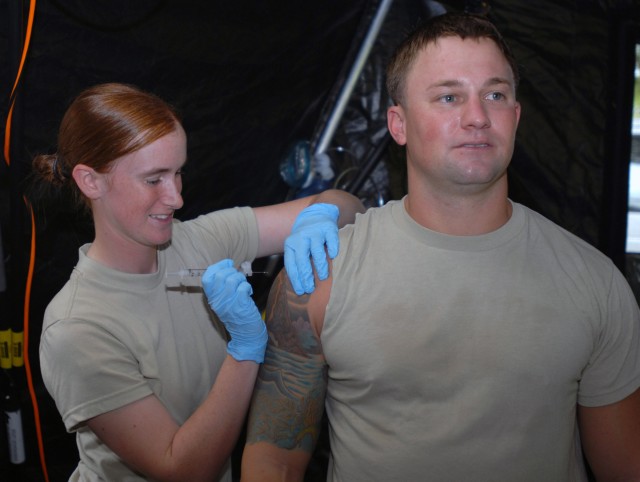FORT SHAFTER, Hawaii (Oct. 16, 2008) - If Fort Shafter were under biological attack from an infectious disease such as avian influenza or Anthrax, how quickly could the entire post be vaccinated'
Few medical crews could successfully conduct a mass inoculation for thousands quickly or efficiently, but Oct. 15, a team of U.S. Army, Pacific and Tripler Army Medical Center medical personnel did, all under the guise of conducting routine annual flu inoculations.
"The average Soldier might think he only just got the flu shot, but actually, this event was testing a much bigger deal. We were testing the Emergency Preparedness Plan, or EPP, for Fort Shafter," said Col. Heidi Warrington, Chief, Army Public Health Nursing, Preventative Medicine, TAMC, who orchestrated the event.
All active duty, Department of Defense civilians, and their dependents on post were invited to the one-day event.
"How quickly can 200 vaccines be given' We did 60 in the first fifteen minutes," said Warrington.
At the days' end, 915 Soldiers and civilians from multiple commands were better equipped to battle the flu.
"It's gone well, even though we had such a minimal amount of time to get the personnel and everything done," said Pvt. Cary Sexton, a USARPAC STB health care specialist who was involved in everything from tent assembly to administering the Flu Mist, a live inactive influenza vaccine.
Staff Sgt. Eli Handler, 94th Army Air Missile Defense Corps health care specialist, said he was given less than 72 hours notice prior to joining the team.
Warrington explained that the short notice and involvement of multiple commands, among other disruptions thrown into the planning process, were intentional and integral to testing the Fort Shafter EPP. "The reality is, a deliberate decision was made to include minimizing advance notification in order to force the preparation in a narrow window of time," she said.
This event involved the annual vaccination, but might just as easily have been an emergency vaccination, or anti-viral medications, theorized Col. Michael Sigmun, chief of preventative medicine at TAMC.
"If there were any kind of emergency, not just pandemic influenza but respiratory illness, we'll know how to react and mobilize folks," he said.
Potential emergency health threats are familiar territory for Sigmun, who also works as the Joint Task Force Hawaii Defense Hawaii Public Health Emergency officer.
"We live in the Pacific where there exists the threat of avian influenza, and since Hawaii is such a transitional point from the Pacific to the mainland United States with airline flights, it is a real threat," he said. "We would like USARPAC to be able to help the people of Hawaii, with all the strength that USARPAC brings, with transportation, logistics, and medical."
In addition to keeping Fort Shafter flu-free and emergency-ready, the flu shot exercise was the first of its kind at Fort Shafter.
With all of these challenges, according to Warrington, requirements and standards of the Joint Commission of Hospital Organization Accreditation and military vaccine agency criteria were still all met.
"Anytime that we can bring effective healthcare for the troops, we increase the loss of training time away from the units, and the more realism we can include, and the more junior the staff that can be involved in the actual planning the better," Warrington said. "If the junior enlisted and officers get it, then the Army wins, but if it takes a colonel to do it, then we lose."
Future events include adding on site MEDPROS [Medical Protection System], an online system that provides medical documentation for Soldiers, so that personnel will have their information instantly updated
"This is the future of military healthcare," stated Warrington. "When these medics go downrange, they will understand how to conduct a mass screening and preventive services."
###


Social Sharing